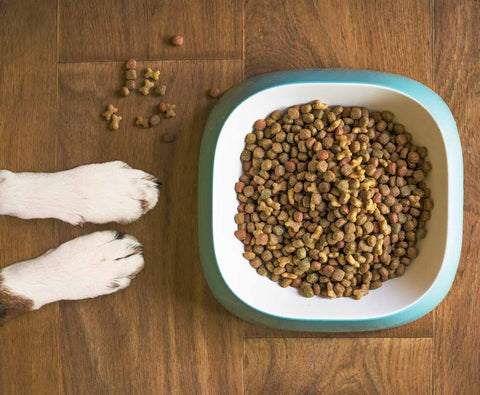

Leg Exercises for Dogs with Cushing’s & Other Joint Issues
Maintaining strong leg muscles is important for all dogs, but especially those dealing with health issues like Cushing’s disease, hip dysplasia, arthritis, or general joint and muscle weakness. As our pups age or manage chronic conditions, their mobility can decline, making daily walks or playtime more difficult. But don’t worry—there are plenty of ways to safely help your dog build and maintain muscle strength from the comfort of your home. Regular, low-impact exercises can support stability, prevent injury, and improve quality of life.
Before starting any new routine, always check with your veterinarian—especially if your dog has a diagnosed condition. Once you have the green light, it’s time to help your pup put their best paw forward.
Why Muscle Strength Matters for Dogs with Cushing’s & Joint Conditions
Dogs with Cushing’s disease often experience muscle wasting, weakness, and fatigue. In fact, one of the early signs of Cushing’s can be difficulty standing up or walking long distances. Similarly, dogs with hip dysplasia, arthritis, or general joint discomfort can lose muscle tone from disuse, which leads to further instability and pain.
Building leg strength helps:
-
Improve balance and coordination
-
Reduce strain on joints and hips
-
Boost mobility and endurance
-
Support long-term joint health
-
Enhance overall quality of life
The key is consistency and choosing exercises that are safe and low impact. It’s not about chasing Olympic gold—it’s about helping your pup stay strong, steady, and happy.
1. Sit-to-Stand Exercises (Dog Squats)
One of the simplest and most effective strength exercises is a modified doggie squat. These "sit-to-stand" routines work your dog’s glutes, thighs, and hips—just like they do in people!
How to do it:
-
Have your dog sit on a stable, non-slippery surface.
-
Gently encourage them to stand up, using a treat if needed.
-
Once standing, ask them to sit again.
-
Repeat this motion 5–10 times, a few times per day.
Over time, this motion builds strength and improves balance. Start slow and watch for signs of fatigue, especially if your dog has joint issues.
2. Controlled Leash Walks on Inclines
Walking uphill naturally engages your dog’s back legs and core muscles, making it an ideal way to build strength without overdoing it. It's like a gym workout—without the need for fancy equipment.
Tips for success:
-
Choose a gentle incline or grassy hill.
-
Keep the pace slow and steady.
-
Limit the duration to 5–10 minutes to start.
-
Monitor for any limping or signs of discomfort.
Dogs with joint or hip conditions may especially benefit from short incline walks a few times per week. Avoid steep or slippery terrain to prevent strain.
3. Balance Work with Cushions or Stability Discs
Balance training is fantastic for rebuilding leg strength and core stability. By gently challenging your dog’s muscles to stay centered, you’re helping activate those smaller stabilizer muscles that are often overlooked.
Try these at-home options:
-
Use a folded yoga mat, couch cushion, or inflatable balance disc.
-
Encourage your dog to stand with all four paws on the surface.
-
Use treats or gentle praise to keep them still for 10–20 seconds at a time.
-
Gradually increase the time as they improve.
This is especially helpful for dogs with Cushing’s, since it addresses both coordination and muscle atrophy.
articleproducts1
4. Weight Shifting Balance Exercises
Weight shifting is a gentle and effective way to improve your dog’s leg strength and balance, especially in dogs recovering from muscle loss or dealing with joint pain.
How to do it:
-
Stand your dog squarely on a non-slip surface.
-
Gently and slowly shift their weight side to side by nudging their hips or shoulders.
-
Try front-to-back shifts as well, encouraging weight distribution between front and rear legs.
-
Start with 10–15 reps of each direction and build from there.
This activity promotes awareness of body position, activates multiple muscle groups, and is great for dogs who can’t handle long walks or higher-impact routines.
5. Water Therapy (Hydrotherapy)
If you have access to a canine hydrotherapy facility, swimming or underwater treadmill sessions can work wonders. Water supports the body’s weight, reducing stress on joints while still allowing resistance-based muscle work.
Benefits of water therapy include:
-
Low-impact, joint-friendly exercise
-
Full-body muscle engagement
-
Improved range of motion
-
Reduced inflammation and stiffness
Even at home, a shallow kiddie pool or bathtub can be used for light resistance walking or standing exercises—just be sure your dog feels safe and supported.
6. Massage for Muscle Support
Massage isn’t just relaxing—it can be a powerful tool for healing and muscle recovery. Gentle, focused massage helps improve blood flow, reduce muscle tightness, and ease joint stiffness in dogs with conditions like Cushing’s or arthritis.
Benefits of canine massage:
-
Stimulates circulation to promote healing
-
Helps prevent muscle atrophy and spasms
-
Increases flexibility and comfort
-
Enhances the bond between you and your pup
Start by gently stroking your dog’s legs and hips, then use small circular motions with your fingers. Pay attention to your dog’s reactions—avoid sensitive areas, and always go slow. If you're unsure, a certified canine massage therapist can offer guidance or perform sessions.
7. Natural Supplements to Support Muscle & Joint Health
Strength training is only one piece of the puzzle. Dogs dealing with chronic conditions like Cushing’s disease, arthritis, or hip issues often benefit from natural supplements that support muscle tone, reduce inflammation, and ease joint stiffness.
Prana Pets offers a variety of holistic options that may help:
-
Adrenal Balance – Supports adrenal function in dogs with Cushing’s
-
Mobility Chews – Helps maintain healthy cartilage and reduce discomfort
-
CBD Oil – Calms inflammation and promotes comfort during recovery
-
Hip & Joint Supplement – A comprehensive blend for aging or mobility-challenged dogs
These can be used alongside exercise routines to give your pup the best shot at staying active and comfortable.
Final Thoughts: Tail-Wagging Results
Leg strengthening routines aren’t just for the sporty pups—they’re essential for dogs managing chronic conditions or entering their golden years. With patience, love, and the right mix of movement and support, your furry friend can stay strong and steady well into the future.
Remember: progress takes time. Celebrate the small wins (like standing up a little faster or walking a little farther), and don’t forget the belly rubs and treats along the way!
articlebanners1




